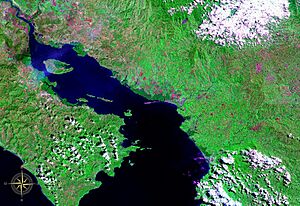Gulf of Nicoya facts for kids
The Gulf of Nicoya (which is called Golfo de Nicoya in Spanish) is a large bay or inlet found on the Pacific Ocean side of Costa Rica. It acts like a natural border, separating the Nicoya Peninsula from the main part of Costa Rica. This area is a beautiful mix of different natural places, including wet marshlands, rocky islands, and tall cliffs along the coast.
The Gulf of Nicoya is very important for Costa Rica. It's a busy place for fishing, and many people visit it for fun activities like boat tours and exploring the islands. It's also a home for lots of amazing wildlife.
Contents
A Look at the Gulf's Geography
The Gulf of Nicoya stretches about 100 kilometers (around 62 miles) from its mouth, where it meets the Pacific Ocean, all the way inland. It's known for its calm waters, especially in the inner parts, which are protected from the big ocean waves. This makes it a safe place for boats and for many sea creatures to live and grow.
Where is the Gulf Located?
The Gulf of Nicoya is located on the western side of Costa Rica. It's bordered by two important provinces: Guanacaste Province to the north and Puntarenas Province to the south and east. The city of Puntarenas, a major port, is located right on the gulf.
Islands of the Gulf
The Gulf of Nicoya is dotted with many islands, each with its own unique features. Some are small and rocky, while others are larger and home to small communities or nature reserves. These islands add to the beauty and ecological richness of the gulf.
Here are some of the main islands you can find in the Gulf of Nicoya:
- Chira Island
- Venado Island
- Isla Caballo
- Isla Bejuco
- Isla San Lucas
- Isla Gitana
- Tortuga Island, Costa Rica
Isla San Lucas: A Historic Island
Isla San Lucas is one of the most well-known islands in the gulf. For many years, it was home to a famous prison. Today, it's a wildlife refuge and a popular spot for tourists to visit. You can learn about its history and enjoy the beautiful nature.
Tortuga Island: A Tourist Favorite
Tortuga Island, Costa Rica is actually a group of two small islands, Alcatraz and Tolinga. It's famous for its white sandy beaches and clear waters, making it a perfect spot for snorkeling and swimming. Many boat tours from the mainland visit Tortuga Island for a day of fun in the sun.
Wildlife and Nature in the Gulf
The Gulf of Nicoya is a vibrant ecosystem, meaning it's a place where many different plants and animals live together. The mix of fresh water from rivers and salty ocean water creates a special environment called an estuary.
Marine Life and Birds
The waters of the gulf are home to a wide variety of marine animals. You can find many types of fish, crabs, and shrimp. Dolphins are often seen playing in the waves, and sometimes even whales visit the deeper parts of the gulf.
The coastal areas and islands are also important for many bird species. You might see pelicans diving for fish, frigatebirds soaring overhead, and various shorebirds looking for food in the mudflats. The mangrove forests along the coast are especially important nurseries for young fish and a nesting ground for birds.
Mangrove Forests and Wetlands
The edges of the Gulf of Nicoya are lined with important mangrove forests and wetlands. Mangroves are special trees that can grow in salty water. They have tangled roots that provide shelter for young fish, crabs, and other small creatures. They also help protect the coastline from erosion and filter pollutants from the water. These wetlands are like natural filters and nurseries for the gulf's ecosystem.
A Glimpse into History
The Gulf of Nicoya has a long history. It was an important area for indigenous people long before Europeans arrived.
First European Landing
The first time Spanish explorers landed in what is now Nicaragua was actually in this very gulf, back in the year 1519. This marked an important moment in the history of the region, as it was one of the first contacts between Europeans and the local people in this part of Central America.
Learn More
- In Spanish: Golfo de Nicoya para niños



